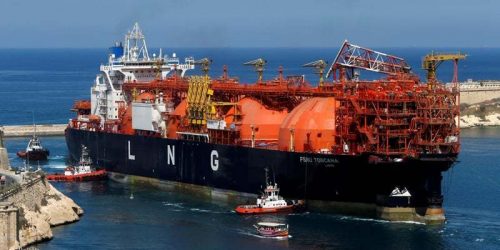ISLAMABAD: The government is likely to sublet unutilised and surplus capacity at existing Liquefied Natural Gas terminals to cut LNG tariff and restrict their further expansion to give a clear signal to private parties for investments in commercial terminals.
An inter-ministerial committee, led by Planning Commission’s deputy chairman Dr Jahanzeb Khan and also comprising secretaries of finance, petroleum and maritime affairs, appointed by the federal cabinet, arrived at this conclusion though it linked a final decision on the quantity of surplus or excess capacity and its viability to a technical study by an international consultant.
Interestingly, the committee report to be taken up by cabinet committee on energy this week completely ignores one of the basic aspects of its creation — how to create LNG storage capacity and how it is ensured that terminal operators do not sell the same capacity twice.
This indicates that last year’s oil shortage problem, which had been attributed to no storage, may be repeated in the LNG case as no new storage capacity is proposed in the report, while greater stress has been put on the value chain despite the safety concerns expressed by public sector LNG companies regarding over-utilisation of the two existing LNG terminals.
The Economic Coordination Committee (ECC) of the cabinet had decided on July 31, 2019 that terminal operators could allocate their additional LNG regasification capacity to a third party on a commercial basis provided the government cargoes “would always have priority on berthing, storage and regasification vis-à-vis private cargo”.
The ECC has also set a condition that if the government was unable to utilise contracted capacity of 600MMCFD at any time, “any sale to private party will be treated as sale of GOP capacity to reduce its take-or-pay” obligation up to 600MMCFD i.e. “terminal cannot resell same capacity twice”.
“No further enhancement or expansion of existing two terminals be allowed, beyond the current agreed plans, in order to give a clear signal to the market for development of new terminals on a merchant basis,” the committee recommended.
It added that independent third-party risk assessment for increased throughput through the terminals and LNG infrastructure should be commissioned by Pakistan LNG Terminals Limited and Sui Southern Gas Company (PLTL/SSGC) in consultation with the terminal operators.
It said the technical and operational risks should be mitigated before increased throughput is allowed on the terminals and Ogra should review the risk assessment and allow utilisation of excess capacity accordingly.
The committee concluded that third party access (TPA), in the first instance, be considered for undisputed excess capacity of 60MMCFD at Terminal-2, belonging to Pakistan Gasport Limited (PGPL). Also, the PGPL can subsequently utilise the 90MMCFD capacity (difference between peak daily delivery capacity and daily delivery capacity) at Terminal-2 if PLTL does not demand it according to an agreed plan. “Revenue sharing on TPA quantity could be based on a reasonable percentage of the tolling tariff applicable on the contracted capacity,” said the report.
As things stand now, both terminal operators offer to pay 25pc of tolling tariff applicable on contracted capacity for excess volumes on a ‘take-and-pay’ basis, while the government entities want operators to pay 75pc of tolling tariff on a “take-or-pay” basis, as they had underwritten complete investment and guaranteed return to operators irrespective of utilisation of terminal capacity.
For Terminal-1 of Engro, in its existing form, there is no claim from the terminal operator regarding excess capacity but it wanted to bring a larger terminal to expand the capacity.
For Terminal-2 of PGPL, 60MMCFD “is clearly an excess capacity as the difference between 750MMCFD (physical capacity) and 690MMCFD (peak daily delivery capacity). The capacity between 600MMCFD (daily delivery capacity) and 690 (peak daily delivery capacity), the way contract is drafted, appears to be available to PLTL as the first right on reasonable endeavour basis. By the same token, if PLTL is not utilising the capacity, it should be available to the operator, for utilisation as excess capacity.
The committee argues that in the absence of Ogra’s TPA rules for dedicated terminals, the negotiated agreement between the parties will have to be endorsed by Ogra and ensure alignment with TPA rules promulgated by the regulator.
In case of Terminal-2, the Operation and Service Agreement (OSA) does not explicitly mention any revenue sharing model. Being a guaranteed terminal, however, there should be a revenue sharing between the terminal operator and the PLTL for utilization of any excess capacity.
The PLTL has terminated the OSA with PGPCL for Terminal-2 and the matter is under arbitration but PLTL and Pakistan Gas-port Consortium Ltd (PGPCL) have, nevertheless, continued the terminal operations, under a court order, which is being implemented by both parties, without prejudice to their respective positions. Since the OSA is in operation, it would logically follow that negotiations between PLTL and PGPCL can be held to arrive at a mutually acceptable TPA arrangement. The agreement on TPA can then be addendum to the OSA.
“The committee recommends an early and amicable settlement of the conflict or dispute between the parties is desirable for a sustainable and optimised operation of the terminal,” notes the report, adding that despite their divergent positions the principles for TPA should preferably be same for all parties so that future excess capacity scenarios could also be covered. At the same time, utilization of the excess capacity and the maximum allowable expansion of the existing terminals/infrastructure should be clarified and publicly announced. This will inform the investors to firm up their investments in the new merchant terminals, the report concludes.





